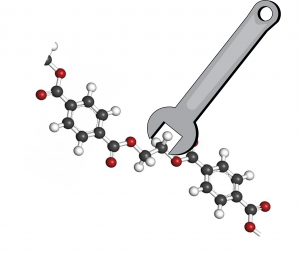Biodegradable Polymer Development
Amino-acid Based Polymer Libraries
 Developing new materials that are biocompatible and have a range of tunable properties can be challenging. Only a few polymer libraries have shown enough supporting data to be commercialized. One approach to designing polymers with strong biocompatibility is to base the monomeric units off of naturally occuring amino acids and their derivatives. Tyrosine is one of a few naturally occuring amino acids that is hydrophobic and contains an aromatic ring. This provides increased chemical stability and structural rigidity. Our lab follows a methodological approach establishing structure-property relationships of our polymers to efficiently design copolymers that meet an application’s specifications. More recently increased thrust towards developing polymers with faster resorption profiles is of interest. Our lab has therefore identified tyrosol as a promising new generation of materials to be used in biomaterials.
Developing new materials that are biocompatible and have a range of tunable properties can be challenging. Only a few polymer libraries have shown enough supporting data to be commercialized. One approach to designing polymers with strong biocompatibility is to base the monomeric units off of naturally occuring amino acids and their derivatives. Tyrosine is one of a few naturally occuring amino acids that is hydrophobic and contains an aromatic ring. This provides increased chemical stability and structural rigidity. Our lab follows a methodological approach establishing structure-property relationships of our polymers to efficiently design copolymers that meet an application’s specifications. More recently increased thrust towards developing polymers with faster resorption profiles is of interest. Our lab has therefore identified tyrosol as a promising new generation of materials to be used in biomaterials.
Polymer-peptide Conjugates
 Many current polymer libraries are effective in matching application mechanical requirements and degradation times but often are bioinert. While this is currently acceptable, our lab aims to further develop materials to include bioactivity. Additional functionality has been added to our polymer libraries by conjugating biomimetic peptides through both surface and bulk modifications. Peptides have been designed to improve the osteogenic potential, promote angiogenesis, and increase cell attachment to our polymers. We have also used peptides as protease-sensitive linkers in both hydrophilic crosslinked networks as well as in thermoplastic backbones.
Many current polymer libraries are effective in matching application mechanical requirements and degradation times but often are bioinert. While this is currently acceptable, our lab aims to further develop materials to include bioactivity. Additional functionality has been added to our polymer libraries by conjugating biomimetic peptides through both surface and bulk modifications. Peptides have been designed to improve the osteogenic potential, promote angiogenesis, and increase cell attachment to our polymers. We have also used peptides as protease-sensitive linkers in both hydrophilic crosslinked networks as well as in thermoplastic backbones.
Functional Polymers for Enhanced Bioactivity
 Incorporating bioactive molecules through covalent and physical linkages is a promising approach to incorporating biological cues that can promote regenerative processes. Utilizing expertise in polymer chemistry and biological sciences, we have successfully developed a polymeric platform that can be functionalized post processing using click-chemistry. The library of materials has been utilized for studying osteogenic differentiation of human mesenchymal stem cells (hMSCs) in 3D printed scaffolds. These scaffolds can bind and deliver bone morphogenetic protein 2 (BMP-2). In addition, this assembly has the potential for a wide range of medical applications including bone fixation devices and scaffolds for bone regeneration. Investigation into additional approaches towards attaching biological cues are being explored.
Incorporating bioactive molecules through covalent and physical linkages is a promising approach to incorporating biological cues that can promote regenerative processes. Utilizing expertise in polymer chemistry and biological sciences, we have successfully developed a polymeric platform that can be functionalized post processing using click-chemistry. The library of materials has been utilized for studying osteogenic differentiation of human mesenchymal stem cells (hMSCs) in 3D printed scaffolds. These scaffolds can bind and deliver bone morphogenetic protein 2 (BMP-2). In addition, this assembly has the potential for a wide range of medical applications including bone fixation devices and scaffolds for bone regeneration. Investigation into additional approaches towards attaching biological cues are being explored.
Polymer Degradation and Analytical Testing
 One key component of designing a biomaterial is ensuring that the material degrades and resorbs in a time frame that matches its desired application. Our lab has focused on defining both hydrolytic and enzymatic degradation mechanisms for both academic and industrial purposes. Our extensive analytical capabilities have allowed us to continue developing unique ways to characterize biomaterials.
One key component of designing a biomaterial is ensuring that the material degrades and resorbs in a time frame that matches its desired application. Our lab has focused on defining both hydrolytic and enzymatic degradation mechanisms for both academic and industrial purposes. Our extensive analytical capabilities have allowed us to continue developing unique ways to characterize biomaterials.